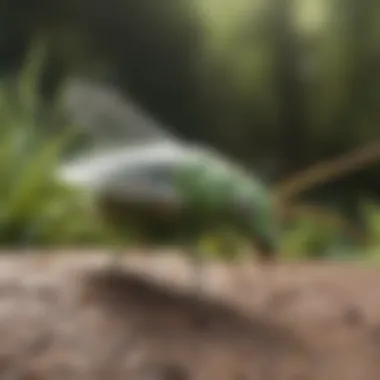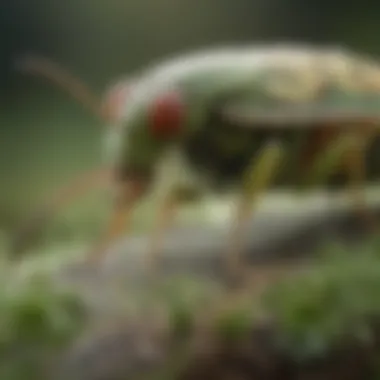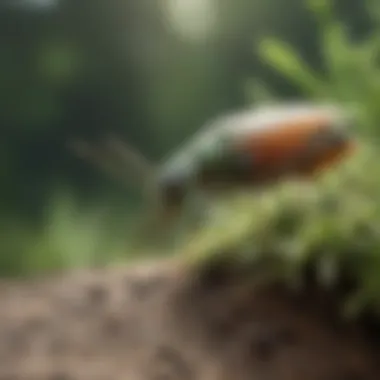Effective Natural Methods for Aphid Removal - A Comprehensive Approach


Animal Species Profile
When it comes to dealing with aphids infesting plants, understanding their characteristics and behaviors is key. Aphids, also known as plant lice, are tiny insects with soft bodies, usually found in clusters on the underside of leaves. They come in various colors, including green, yellow, and black, depending on the species. Aphids can reproduce rapidly, leading to extensive damage to plants if left unchecked. Their natural habitat includes gardens, agricultural fields, and wooded areas, where they feed on plant sap using their needle-like mouthparts.
Aphids exhibit interesting social interactions within their colonies. They communicate through various chemical signals to alert others of danger or to attract mates. Interestingly, some aphid species have developed symbiotic relationships with ants, providing them with honeydew in exchange for protection from predators. Understanding these aspects of aphid behavior is crucial in developing effective natural control strategies.
Conservation & Wildlife Efforts
While aphids are not typically targeted for conservation efforts due to their rapid reproductive rate and abundance, their presence can have significant impacts on crops and plant health. Aphids can transmit plant diseases, further threatening agricultural productivity. To mitigate these impacts, integrated pest management approaches are often employed, combining natural predators, organic repellents, and cultural practices to control aphid populations naturally.
Various organizations focus on sustainable agricultural practices that reduce the need for chemical insecticides, promoting ecosystem health and biodiversity. Success stories in aphid control include the introduction of beneficial insects like ladybugs and lacewings, which help keep aphid populations in check without harming the environment.
Animal Behavior & Psychology
Aphids may seem simple insects, but their behaviors and interactions with their environment are intricate. Through the release of pheromones, aphids can communicate alarm signals to warn others of impending threats, such as predatory insects. Reproductively, aphids can give birth to live young without mating, a strategy that allows for rapid population growth.
Studies have also shown that aphids exhibit some level of cognitive abilities, recognizing and responding to environmental cues such as changes in plant chemistry or the presence of natural enemies. While emotional intelligence may not be applicable to aphids in the same way as to mammals, their ability to adapt to changing conditions showcases a form of social dynamics within their colonies.
Unique Facts & Trivia
Did you know that aphids reproduce asexually during the spring and summer months, leading to explosive population growth? These tiny insects are also known for their ability to produce honeydew, a sweet secretion that attracts ants and can lead to mold growth on plants. Additionally, some aphid species exhibit wing polymorphism, where certain individuals develop wings to colonize new plant hosts.
Despite their reputation as agricultural pests, aphids play a vital role in ecosystems as a food source for predators like birds, insects, and spiders. Their prolific reproductive capabilities and adaptability to various plant species make them fascinating subjects for study and observation.
Pet Care & Tips
While aphids are more commonly associated with plant care than pet ownership, ensuring a healthy environment for beneficial insect allies like ladybugs can indirectly help control aphid populations in gardens. Incorporating diverse plant species that attract natural predators of aphids can create a balanced ecosystem that reduces the need for chemical interventions.
For indoor plants, regularly inspecting leaves for signs of aphid infestations and gently washing them off with a water spray can help keep populations in check. Avoid over-fertilizing plants, as this can make them more susceptible to aphid damage. By promoting biodiversity in your garden and understanding the role of aphids in the larger ecosystem, you can contribute to sustainable pest management practices.


Introduction
In this meticulously curated guide on natural ways to remove aphids, we delve deep into the intricate world of combating these tiny pests that wreak havoc on our beloved plants. Aphids, with their insidious presence, pose a significant threat to the vitality of our green companions. By understanding their characteristics, reproductive cycle, and the detrimental effects they have on plants, we equip ourselves with the knowledge needed to protect our botanical friends.
Understanding Aphids
In dissecting the physical characteristics of aphids, we unravel fascinating details about these minuscule creatures that appear harmless at first glance. Their delicate bodies, often pear-shaped and adorned in varying colors, serve as camouflage amidst the foliage they infest. The waxy coating they possess acts as armor against predators, enabling them to thrive in diverse environments. Understanding the reproductive cycle of aphids reveals their astonishing abilities to multiply rapidly, causing exponential harm to plants in a short span. The viviparous nature of aphids, allowing them to produce live young without mating, amplifies the speed at which they colonize plants. Their ability to inflict damage through sap extraction weakens plant vigor, making them susceptible to diseases.
Importance of Natural Pest Control
Embracing natural pest control methods heralds a sustainable approach to preserving the delicate balance of our ecosystems. The benefits of utilizing natural methods extend beyond mere aphid removal, fostering a harmonious environment where beneficial insects thrive. By eschewing harsh chemicals, we safeguard biodiversity and promote the longevity of our plant life. The impact on the environment becomes significantly positive as we reduce the ecological footprint typically associated with chemical interventions. Promoting beneficial insects, such as ladybugs and lacewings, emerges as a strategic move in establishing a natural aphid suppression system. These winged allies devour aphids with voracity, maintaining a natural equilibrium in our gardens.
Preventive Measures
In this segment of the comprehensive guide on natural ways to remove aphids, we delve into the critical aspect of Preventive Measures. When contemplating the management of aphids on plants, instituting preventive measures emerges as a foundational pillar of an effective pest control strategy. By incorporating preemptive tactics, individuals can curtail aphid infestations before they escalate, safeguarding the vitality of their plants without resorting to chemical interventions. Preventive measures not only act as a barrier against aphids but also promote the overall health and resilience of garden ecosystems, aligning with sustainable horticultural practices. Embracing preventive solutions not only mitigates aphid-related damages but also fosters a harmonious coexistence between plants and their natural predators, fostering biodiversity within the garden environment.
Companion Planting
Plants that repel aphids
Delving into the realm of Companion Planting, the focus shifts towards Plants that repel aphids. Selecting specific plant species known for their natural aphid-repelling properties serves as an ingenious approach to pest management without the need for chemical interventions. Plants such as marigolds, chrysanthemums, and lavender emit odors or substances that act as natural deterrents against aphids, reducing the likelihood of infestations in the garden. Incorporating these aphid-repellent plants within the garden landscape not only enhances aesthetic appeal but also contributes to a holistic pest control strategy, fostering a symbiotic relationship between different plant species.
Discussing the unique feature of Plants that repel aphids, their aromatic compounds discourage aphid colonization, thus preserving the health and vigor of surrounding plant life. The advantages of utilizing Plants that repel aphids lie in their non-invasive nature, steering clear of chemical residues while effectively protecting plants from aphid damage. Embracing these natural repellents underscores a conscientious approach to pest management, promoting a balanced ecosystem within the confines of the garden.
Creating a diverse garden
Elevating the discussion within Companion Planting leads us to the concept of Creating a diverse garden. A diverse garden landscape, characterized by an assortment of plant species with varying heights, textures, and colors, not only enhances visual appeal but also plays a pivotal role in natural pest control. The biodiversity within a diverse garden cultivates a habitat that attracts beneficial insects and predators that naturally prey on aphids, bolstering the garden's resistance to pest infestations.
The primary advantage of a diverse garden lies in its ability to harbor a multitude of beneficial insects that serve as natural adversaries to aphids, maintaining ecological equilibrium within the garden ecosystem. By creating a habitat rich in plant diversity, individuals inadvertently create a self-sustaining environment that harmonizes the intricate balance between plant life and natural pest management mechanisms. Embracing the concept of a diverse garden underscores a proactive approach to pest control, harnessing the power of biodiversity to combat aphid infestations sustainably.


Maintaining Plant Health
Delving deeper into the domain of Preventive Measures, we direct our attention to Maintaining Plant Health as a fundamental component of efficient aphid management. Proper watering techniques stand as a cornerstone of plant health maintenance, ensuring adequate hydration without predisposing plants to aphid attraction. By adhering to appropriate watering practices tailored to specific plant species, individuals can fortify plants against stressors that make them susceptible to aphid attacks.
Emphasizing the significance of Proper watering techniques in plant health maintenance underscores the pivotal role of hydration in bolstering plants' natural defenses against pest invasions. The judicious application of water promotes plant vigor and resilience, creating an inhospitable environment for aphids to thrive. The advantages of proper watering techniques extend beyond aphid control, contributing to overall plant well-being and vitality within the garden ecosystem.
Turning our focus to Nutrient-rich soil management within Maintaining Plant Health, the emphasis shifts to soil fertility as a critical determinant of plant resilience against aphid infestations. Nutrient-rich soil supports robust plant growth, enhancing their ability to withstand pest pressures and environmental stressors. By optimizing soil nutrient levels through organic amendments and compost applications, individuals can cultivate plants that are inherently less appealing to aphids due to their optimal health and vigor.
The essence of Nutrient-rich soil management lies in its capacity to provide plants with essential nutrients that fortify their immune systems and structural integrity, acting as a natural deterrent to aphid infestations. The advantages of nutrient-rich soil management encompass not only pest resistance but also improved plant productivity and yield, symbolizing a holistic approach to plant care that transcends mere pest control measures. Embracing soil enrichment practices embodies a proactive strategy towards aphid management, underscoring the pivotal role of optimal nutrition in cultivating thriving garden ecosystems.
Natural Remedies
Natural remedies play a crucial role in the realm of aphid control, offering a sustainable and eco-friendly approach to tackling these troublesome pests. In this article, we delve into various natural remedies that can effectively deter and eliminate aphids from plants without resorting to harmful chemicals. These remedies not only help in curbing aphid populations but also contribute to maintaining a healthy ecosystem within your garden or farm. By exploring homemade aphid sprays and beneficial insects, we equip you with the necessary knowledge to combat aphids naturally, promoting a harmonious balance in your plant environment.
Homemade Aphid Sprays
Homemade aphid sprays represent a practical and accessible method for eradicating aphids without introducing toxins into the eco-system. Within this category, several options stand out for their effectiveness in controlling aphid infestations. These include neem oil spray, garlic and chili pepper spray, and the soapy water solution. Each of these sprays carries unique properties that target aphids while being gentle on plants, making them ideal choices for environmentally conscious gardeners seeking natural pest management solutions.
Neem oil spray
Neem oil spray stands out as a popular choice for combating aphids due to its natural insecticidal properties. Derived from the neem tree, this organic spray disrupts aphids' reproductive cycles and deters them from infesting plants. Its effectiveness in controlling aphid populations while being safe for other beneficial insects makes it a favored option among organic gardeners and environmentally-conscious individuals. Although neem oil spray holds advantages in pest control, certain factors like application frequency and potential leaf damage should be considered when incorporating it into your aphid management strategy.
Garlic and chili pepper spray
Garlic and chili pepper spray offers a potent and natural deterrent against aphids, utilizing the strong aromas and compounds present in garlic and chili peppers to repel these pests. This homemade solution acts as a barrier, making plants less appealing to aphids while serving as a cost-effective and non-toxic alternative to commercial pesticides. The unique combination of garlic and chili pepper not only targets aphids but also acts as a preventive measure, creating an inhospitable environment for aphids to thrive. However, it is important to note that the intense nature of this spray may require caution during application to prevent any adverse effects on delicate plant foliage.
Soapy water solution
Among the DIY aphid sprays, the soapy water solution emerges as a simple yet effective remedy for controlling aphid populations on plants. By disrupting the waxy outer layer of aphids, this solution suffocates and dehydrates the pests, leading to their eventual demise. The ease of preparation and application make soapy water an accessible choice for gardeners looking to combat aphid infestations naturally. Despite its efficacy, regular monitoring of plants and potential phytotoxicity issues are aspects that should be considered when utilizing this remedy in aphid control strategies.


Organic Control Methods
Organic control methods play a pivotal role in the holistic approach to managing aphid infestations. Emphasizing environmentally friendly solutions, organic methods provide a sustainable way to tackle pest issues without harming beneficial insects or disrupting the ecosystem. By utilizing DIY traps, barriers, and natural repellents, gardeners can effectively control aphids while promoting a healthy garden environment. These methods not only target pests directly but also foster long-term resilience in plants against future infestations.
DIY Traps and Barriers
Yellow Sticky Traps
Yellow sticky traps are a fundamental component of organic pest control strategies. These bright yellow adhesive traps effectively capture aphids, whiteflies, and other flying insects by luring them onto the sticky surface. The vibrant color of these traps attracts pests, offering an efficient way to monitor and reduce aphid populations in a non-toxic manner. While yellow sticky traps are affordable and easy to use, they may require regular replacement, especially in high infestation areas.
Aluminum Foil Barriers
Aluminum foil barriers serve as a physical deterrent against aphids and other crawling pests. By wrapping the base of plant stems with aluminum foil, gardeners create a barrier that prevents aphids from ascending and feeding on plant sap. This method is particularly effective for protecting young plants or seedlings vulnerable to pest attacks. Additionally, aluminum foil barriers reflect light, potentially deterring aphids with their shiny surface. However, it's essential to check and adjust these barriers regularly to ensure continued effectiveness.
Pruning and Plant Inspection
Removing Infested Plant Parts
Removing infested plant parts is a crucial step in organic pest management. By pruning and discarding heavily infested leaves or stems, gardeners can eliminate aphid colonies and prevent further spread of the infestation. This targeted approach reduces the aphid population and minimizes damage to plant tissues, promoting overall plant health. Regularly inspecting plants for signs of aphids enables timely intervention, enhancing the effectiveness of removal techniques.
Regular Plant Checks
Frequent plant checks are essential for early pest detection and intervention. By regularly inspecting both the upper and lower surfaces of leaves, gardeners can identify aphid infestations at their initial stages. Early detection allows for prompt action, such as manual removal of aphids or application of organic sprays. Regular plant checks also help monitor plant growth and health, enabling adjustments to care routines as needed. Overall, consistent monitoring plays a vital role in maintaining a pest-free and thriving garden environment.
Conclusion
When reflecting on the holistic approach to combatting aphids naturally, the conclusion section serves as a pivotal element in underscoring the significance of sustainable pest management practices within the broader context of this article. It encapsulates the essence of utilizing eco-friendly methods to deter aphid infestations without resorting to harsh chemicals or pesticides. By incorporating preventive measures and organic control strategies, this conclusive segment imparts invaluable knowledge about fostering a harmonious equilibrium in the garden ecosystem. The relevance of the conclusion extends beyond mere aphid eradication, emphasizing the long-term benefits of promoting biodiversity and enhancing plant resilience against pest intrusions. Consequently, readers are not only equipped with practical solutions for immediate pest control but also encouraged to adopt a proactive stance towards cultivating environmentally-friendly gardening practices.
Summary of Natural Aphid Control
Key takeaways on aphid removal naturally
Key takeaways on aphid removal naturally epitomizes an integral component of this guide, offering a systematic breakdown of effective strategies to combat aphid infestations through natural means. By elucidating the potency of homemade aphid sprays and the beneficial role of insects like ladybugs and lacewings, this section accentuates the importance of deploying holistic remedies to ensure sustainable pest management. The distinguishing feature of key takeaways on aphid removal naturally lies in its ability to address aphid issues while safeguarding ecological balance, making it a favored choice among conscientious gardeners. This approach not only curtails immediate infestation concerns but also fosters a harmonious coexistence between plants and beneficial insects, ensuring long-term pest resilience. The versatile nature of these natural aphid control methods equips readers with a sustainable arsenal to combat future aphid challenges effectively.
Sustainable practices for pest management
Sustainable practices for pest management serve as the backbone of eco-conscious gardening, offering a comprehensive blueprint for mitigating pest pressures without compromising environmental integrity. This subsection sheds light on the efficacy of DIY traps and barriers in minimizing aphid populations, alongside advocating for regular plant inspections and prudent pruning practices. The hallmark feature of sustainable practices for pest management lies in its promotion of non-invasive, chemical-free solutions that prioritize ecosystem health over immediate pest eradication. By emphasizing the importance of maintaining a natural pest balance and leveraging nature's intrinsic mechanisms, this approach advocates for a proactive, preventive stance against pest incursions. While these practices may require consistent monitoring and patience, their long-term benefits outweigh the temporary conveniences of chemical interventions, making them an indispensable facet of sustainable gardening practices.







